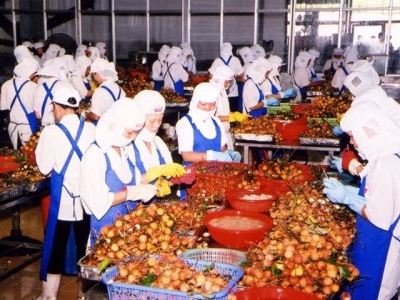Fruit exports top concern for provinces

Litchi process chain at Đồng Giao Foodstuff Export Joint Stock Company (Doveco)’s factory in Ninh Bình City. — VNA/VNS Photo Đình Huệ
HÀ NỘI — The northern provinces of Bắc Giang, Hưng Yên, Hải Dương and Sơn La have proposed boosting exports of litchi and longan to foreign markets, including China.
The proposal was the key topic of discussion at Wednesday’s annual conference in Hà Nội on the production and distribution of these two main fruit products in northern areas.
Per the request, the Ministry of Agriculture and Rural Development (MARD), Ministry of Industry and Trade and Ministry of Foreign Affairs will arrange talks with their Chinese counterparts to promote Vietnamese fruits’ entrance into the country, via negotiation, plant quarantine agreements and removing technical barriers.
Minister of Agriculture and Rural Development Nguyễn Xuân Cường expressed determination to help the provinces sell their products at home and abroad.
Nguyễn Hồng Sơn, head of MARD’s Crop Production Department, said domestic litchi and longan consumption accounts for about 50 per cent of output, albeit this number is on the rise, mainly in urban areas.
Therefore, it is necessary to focus on these markets, by connecting producers with chain distributors and wholesale markets, while keeping current importers satisfied, such as China, the US, Japan and Australia.
He said that Vietnamese agricultural products are still accepted in China with little obstacles regarding regulations on origin and plant quarantine.
Hoàng Trung, Director General of the MARD’s Plant Protection Department (PPD), said this year, his unit will conduct its first on-site tests for litchi and longan crops during the harvest season in the provinces.
The PPD will arrange mobile quarantine rooms in concentrated areas to issue certificates on the spot for exporting enterprises, instead of doing so at the border. This will help reduce congestion and shorten clearance time at the border, said Trung.
The PPD has also been negotiating for higher fruit exports quota to Japan and South Korea, as many Japanese and Korean companies are keen on importing these fruits.
Meanwhile, Nguyễn Thị Thu Hà, Vice Chairwoman of Bắc Giang Provincial People’s Committee, said her province considers litchi the key driver for economic development.
As current local production accounts for nearly 29,000 hectares, 2018’s output is estimated at 150,000 to 180,000 tonnes, nearly double last year’s number, said Hà.
Such abundant yields, coupled with short harvesting time, storage and transportation difficulties, have pressured the province to find an appropriate consumption market.
At present, the Chinese province of Guangxi has requested proof of traceability for Việt Nam’s agricultural products, which means the province must negotiate with Chinese partners to resolve any remaining difficulties.
Hà said that Bắc Giang Province will hold several litchi promotion conferences, starting with one in Pingxiang, China in May 2018, Bắc Giang in June 2018, and one Litchi week in Hà Nội later on.
Meanwhile, Minister Cường suggested that Sơn La Province soon complete constructing two fruit and vegetable processing plants, in order to help reduce pressure on fresh fruits preservation.
Nguyễn Văn Phóng, Chairman of Hưng Yên Provincial People’s Committee, said that his province’s litchi and longan output had increased 15 and 20 per cent, respectively in 2017.
Hưng Yên Province will organise a conference to link supply and demand, promote trade promotion, and invite local businesses to discuss solutions to litchi consumption, as well as several trade fairs in the Ecopark urban township development, or another one on Hoàng Quốc Việt Street, Hà Nội.
In 2018, litchi storage technology from Israel will be transferred to the Ministry of Science and Technology, which the MARD will then apply at eight fruit and vegetable processing plants at the soonest.
On the same note, Trần Công Trưởng, Vice Chairman Lạng Sơn Provincial People’s Committee, said China had asked his province to impose tighter controls on agricultural goods entering China via Lạng Sơn border gate.
Starting May 1 this year, farmers will be required to provide proper packaging and product labels in order to export to China.
To meet the requirements of traditional export markets and to expand to new markets for fruit and nuts, Việt Nam needs to improve its activities in terms of quality, design and food safety.
Đinh Cao Khuê, General Director of the Đồng Giao Foodstuff Export Joint Stock Company, said that his company has about 5,000 tonnes of processed litchi ready for export, with prospects for fresh exports as well.
Khuê was confident that Vietnamese products are strong enough to compete with other countries’, though they still need promotions abroad.
Litchi and longan are the two main fruit-bearing crops in northern provinces, with a total area of 98,000 hectares, accounting for 27 per cent of total agricultural harvest, whose accumulated output is estimated to exceed 217,000 tonnes in 2018.
Có thể bạn quan tâm
 Hi-tech fruit cultivation area built in Luc Ngan district
Hi-tech fruit cultivation area built in Luc Ngan district Building hi-tech fruit cultivation area aims at increasing the trademark value for fruit orchards in Luc Ngan district to meet the markets’ fastidious demand.
 Bac Giang strictly supervises litchi production
Bac Giang strictly supervises litchi production To facilitate litchi selling and meet the export demand. application of VietGAP, GlobalGAP standards, ensuring their products eligible to get stamps of origin.
 Supply chain innovation required for agriculture growth
Supply chain innovation required for agriculture growth Vietnam needs to renovate supply chain to help its agriculture sector improve the competitive edge and grow effectively, experts said.